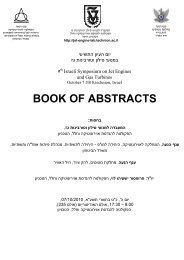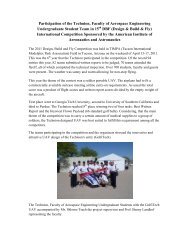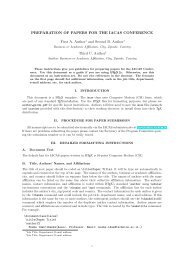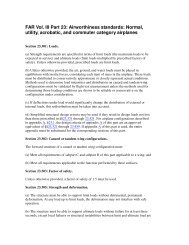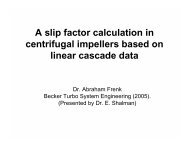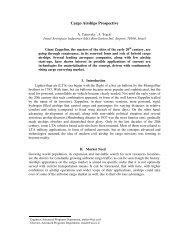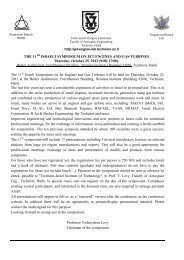A Century of Ramjet Propulsion Technology Evolution - Faculty of ...
A Century of Ramjet Propulsion Technology Evolution - Faculty of ...
A Century of Ramjet Propulsion Technology Evolution - Faculty of ...
Create successful ePaper yourself
Turn your PDF publications into a flip-book with our unique Google optimized e-Paper software.
vehicles, which can be interrogated for safety, reliability and cost<br />
impacts <strong>of</strong> the proposed technologies.<br />
Flight-tests supporting NASA’s Third Generation Space Access<br />
focuses on incremental development and demonstration <strong>of</strong> key technology<br />
that can not be demonstrated to a <strong>Technology</strong> Readiness<br />
Level (TRL) <strong>of</strong> 6 in ground tests. These start with scramjet performance,<br />
operability and airframe integration (X-43A, X-43C and<br />
X-43D) for flight Mach numbers from 5 to 15. These first demonstrators<br />
are expendable to reduce test costs. The next step is integration<br />
<strong>of</strong> low-speed (Mach 0 to 3+) with the scramjet system in a reusable<br />
“combined cycle” flight demonstration (RCCFD). The first step for<br />
RCCFD is a Mach 0-7 reusable air-launched research vehicle, similar<br />
in size to the X-15. The final step would be a larger vehicle<br />
capable <strong>of</strong> operation to full airbreathing Mach number required for<br />
the 2025 IOC vehicle.<br />
International activity in this period continued to include many<br />
developments. A joint French/Russian program Wide Range <strong>Ramjet</strong><br />
(WRR) was initiated to develop technology for reusable<br />
space launcher applications. France also began the development<br />
<strong>of</strong> Joint Airbreathing Research for Hypersonic Application Research<br />
(JAPHAR) in cooperation with Germany as follow-on to<br />
the PREPHA (France) and Sänger (Germany) programs to pursue<br />
hypersonic airbreathing propulsion research for reusable space<br />
launcher applications. Furthermore France initiated Promethée<br />
aimed at developing fully variable-geometry endothermic hydrocarbon<br />
fuel dual-mode ramjet technology for military applications.<br />
The French efforts are leading toward LEA, a new flight-test demonstration<br />
<strong>of</strong> a high-speed dual-mode ramjet propelled vehicle at flight<br />
conditions <strong>of</strong> Mach 4–8 in the 2010–2012 time frame. In this era,<br />
Russia began openly discussing their development <strong>of</strong> AJAX, an<br />
innovative hypersonic vehicle concept envisioned to capture and recycle<br />
energy otherwise lost in flight at high Mach numbers. Russia<br />
also initiated second generation hypersonic flying laboratory work<br />
with Gela Phase II and the Mig-31 HFL. Australia conducted, with<br />
international support, the world’s first verified demonstration <strong>of</strong> supersonic<br />
combustion in a flight environment under HyShot.<br />
The development <strong>of</strong> vehicles for space access applications reflected<br />
maturation in propulsion technology and the technical interests<br />
<strong>of</strong> the times. Initial concepts, for example, the German<br />
Sänger–Bret Silbervögel <strong>of</strong> 1938, postulated single-stage-to-orbit<br />
(SSTO) vehicles based on pure rocket systems, or rocket-l<strong>of</strong>ted<br />
boost-gliders, such as the U.S. Dyna-Soar. The U.S. Air Force supported<br />
Spaceplane development followed, which spawned imaginative<br />
upper atmospheric high-Mach air collection and oxygen<br />
extraction technologies. The understanding <strong>of</strong> scramjet technology<br />
had began. By the early 1960s, the maturation <strong>of</strong> advanced<br />
airbreathing technology encouraged a redirection toward complex<br />
fully reusable TSTO vehicles with airbreathing first stages (with<br />
combinations <strong>of</strong> turbojets, turboramjets, or ramjets/scramjets) and<br />
rocket-boosted second stages. The economic realities <strong>of</strong> the 1970s<br />
dictated using semi-expendable, pure-rocket approaches, typified<br />
by the space shuttle. The potentialities <strong>of</strong> the advanced airbreathing<br />
scramjet <strong>of</strong> the 1980s led to NASP and horizontal take<strong>of</strong>f and landing<br />
concepts for airbreathing SSTO vehicles using complex propulsion<br />
systems dependent on new high-energy fuel concepts and the<br />
air collection and oxygen extraction technologies developed previously.<br />
The 1990s witnessed less ambitious goals <strong>of</strong> developing<br />
either pure advanced rocket systems (X-33 and X-34) or systems<br />
using straightforward scramjet technology (X-43A Hyper-X). The<br />
first flight demonstration <strong>of</strong> scramjet-propelled vehicle designs with<br />
true potential for enabling space access promises to become reality<br />
in 2003–2004.<br />
These and other international development programs are reviewed<br />
in further detail later as a means <strong>of</strong> better understanding the evolution<br />
in scramjet technology.<br />
<strong>Evolution</strong> in <strong>Ramjet</strong> and Scramjet<br />
Development Programs<br />
The development <strong>of</strong> ramjet technology for multiple applications<br />
has proceeded in parallel throughout history. Applications have<br />
ranged from boost- to main-propulsion for aircraft, gun projectiles,<br />
FRY 35<br />
missiles, and space launch vehicles. The intent here is to highlight<br />
international activity and selected programs as a means <strong>of</strong> identifying<br />
sources <strong>of</strong> technology advances, <strong>of</strong>ten resulting from parallel<br />
efforts in multiple applications.<br />
The key enabling technologies, components, or events that had<br />
significant impact on the maturation <strong>of</strong> ramjet propulsion and engine<br />
designs, summarized in Table 1, are briefly discussed relevant to the<br />
worldwide development <strong>of</strong> vehicle concepts and systems. The history<br />
<strong>of</strong> the worldwide subsonic and supersonic combustion ramjet<br />
evolution is summarized by era in Tables 2–6 from the turn <strong>of</strong> the<br />
century to today. Presented in Tables 2–6 for each ramjet/scramjet<br />
system are known historical era, originating country, engine/vehicle<br />
name, engine cycle type, development dates, design cruise Mach<br />
number, altitude and range performance, system physical characteristics,<br />
and state <strong>of</strong> development. The ranges provided are a mix<br />
depending on the engine/vehicle development status: operational<br />
range for operational systems, predicted range for concept vehicles,<br />
or demonstrated range for flight-test vehicles. Additionally, those<br />
engines/vehicles that are discussed and illustrated in this paper are<br />
indicated. Many observations can be drawn from the data shown in<br />
Tables 2–6 and include the following.<br />
1) <strong>Ramjet</strong> technology development has been consistently pursued<br />
internationally from very early days, accompanied by steady<br />
increases in airbreathing system capabilities.<br />
2) <strong>Ramjet</strong> engines have received substantially more attention than<br />
scramjet engines, with scramjet development increasing steadily<br />
since the early 1990s, which reflects the accelerating pace in the<br />
solution <strong>of</strong> the challenges <strong>of</strong> high speed flight.<br />
3) Although at the verge <strong>of</strong> success, flight testing <strong>of</strong> ramjetpowered<br />
engine concepts at hypersonic speeds has yet to be accomplished.<br />
At this writing the U.S. X-43A Hyper-X is planned for<br />
a second flight test in January 2004.<br />
<strong>Ramjet</strong> Development 1918–Today<br />
<strong>Ramjet</strong> Development: 1918–1960<br />
This era saw the birth <strong>of</strong> ramjet-powered aircraft flight and its<br />
rapid maturing <strong>of</strong> technology into primarily missile applications<br />
and its transition from subsonic to supersonic ramjet flight. Table 2<br />
summarizes ramjet evolution in the era from 1918 to 1960 and provides<br />
originating country, engine/vehicle name, development dates,<br />
performance, physical characteristics, and state <strong>of</strong> development.<br />
Countries actively engaged in development in this era were France,<br />
Germany, the United States, the United Kingdom and Russia.<br />
The Germans flew the first operational ramjet-powered missile<br />
in 1940 in the form <strong>of</strong> the V-1 buzzbomb (Fig. 8) powered by a<br />
subsonic flight speed pulsejet engine launched by a solid propellant<br />
booster. The V-1 could be considered the first cruise missile.<br />
German engineer, Paul Schmidt, working from a design <strong>of</strong> the Lorin<br />
tube, developed and patented (June 1932) a ramjet engine (Argus<br />
pulse jet) that was later modified and used in the V-1 Flying Bomb.<br />
The German V-1 technology was transferred to other countries after<br />
WWII.<br />
The first ramjet-powered airplane was conceived and variants<br />
tested by Leduc <strong>of</strong> France. The first powered flight <strong>of</strong> a ramjetpowered<br />
aircraft, Leduc-010 (Fig. 9), took place in April 1949<br />
Fig. 8 German V-1 operational WW II missile (1933–1945).






